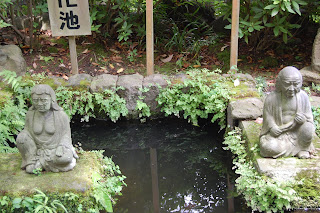


Please remember that what I write here are my impressions and should NOT be construed as authoritative.
Evidence of how comfortably the Japanese people straddle three of the world’s major religions abounds in the shrines, temples and churches scattered throughout the cities and country side. Shintoism, an ancient worship with deep roots in Japanese soil, appears in both small and large shrines often nestled in amongst the larger more impressive Buddhist Temples. Reverence for the natural world permeates the Shinto belief system where both animate and inanimate objects have souls. Often cars and homes are blessed to protect them against bad luck and misfortune. When Buddhism came to Japan via Korea and China, the Japanese embraced a religion that focuses on the individual’s spiritual enlightment of the soul. As far as I understand, Buddhism did not negate the beliefs embedded within Shintoism and therefore these religions still co-exist today. Christianity arrived late sometime in the 15th century and again the Japanese managed to adapt the tenants of Christian morality to their eastern cultural identity. Although less than 1% of Japanese today consider themselves to be Christian, a very large number of brides and grooms include a western, Christian aspect to their wedding. A typical Japanese wedding will have many changes of costumes, one of which is the White Wedding gown that marks a Christian ceremony. Today when the Japanese are polled and asked what religion they practice, the total percent exceeds 100. Apparent in these statistics, Japanese people identify themselves with more than one religion. From these statistics also, one would assume that the Japanese are considerably religious people, yet according to my guides, religion in Japan is practiced more for its traditional influence rather than for its strict adherence to dogmatic practice.
